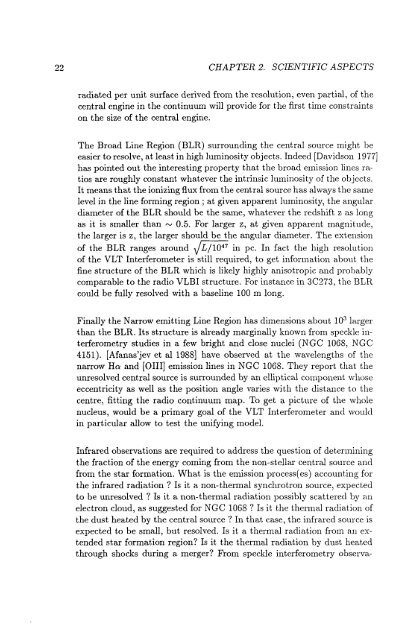The VLT Interferometer - ESO
The VLT Interferometer - ESO
The VLT Interferometer - ESO
Create successful ePaper yourself
Turn your PDF publications into a flip-book with our unique Google optimized e-Paper software.
22 CHAPTER 2. SCIENTIFIC ASPECTS<br />
radiated per unit surface derived from the resolution, even partial, of the<br />
central engine in the continuum will provide for the first time constraints<br />
on the size of the central engine.<br />
<strong>The</strong> Broad Line Region (BLR) surrounding the central source might be<br />
easier to resolve, at least in high luminosity objects. Indeed [Davidson 1977J<br />
has pointed out the interesting property that the broad emission lines ratios<br />
are roughly constant whatever the intrinsic luminosity of the objects.<br />
It means that the ionizing flux from the central source has always the same<br />
level in the line forming region; at given apparent luminosity, the angular<br />
diameter of the BLR should be the same, whatever the redshift z as long<br />
as it is smaller than "-' 0.5. For larger z, at given apparent magnitude,<br />
the larger is z, the larger should be the angular diameter. <strong>The</strong> extension<br />
of the BLR ranges around JL/10 47 in pc. In fact the high resolution<br />
of the <strong>VLT</strong> <strong>Interferometer</strong> is still required, to get information about the<br />
fine structure of the BLR which is likely highly anisotropic and probably<br />
comparable to the radio VLBI structure. For instance in 3C273, the BLR<br />
could be fully resolved with a baseline 100 m long.<br />
Finally the Narrow emitting Line Region has dimensions about 10 3 larger<br />
than the BLR. Its structure is already marginally known from speckle interferometry<br />
studies in a few bright and close nuclei (NGC 1068, NGC<br />
4151). [Afanas'jev et al 1988] have observed at the wavelengths of the<br />
narrow Ho: and [OIII] emission lines in NGC 1068. <strong>The</strong>y report that the<br />
unresolved central source is surrounded by an elliptical component whose<br />
eccentricity as well as the position angle varies with the distance to the<br />
centre, fitting the radio continuum map. To get a picture of the whole<br />
nucleus, would be a primary goal of the <strong>VLT</strong> <strong>Interferometer</strong> and would<br />
in particular allow to test the unifying model.<br />
Infrared observations are required to address the question of determining<br />
the fraction of the energy coming from the non-stellar central source and<br />
from the star formation. What is the emission process( es) accounting for<br />
the infrared radiation? Is it a non-thermal synchrotron source, expected<br />
to be unresolved? Is it a non-thermal radiation possibly scattered by an<br />
electron cloud, as suggested for NGC 1068 ? Is it the thermal radiation of<br />
the dust heated by the central source? In that case, the infrared source is<br />
expected to be small, but resolved. Is it a thermal radiation from an extended<br />
star formation region? Is it the thermal radiation by dust heated<br />
through shocks during a merger? From speckle interferometry observa-

















